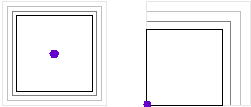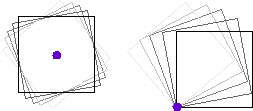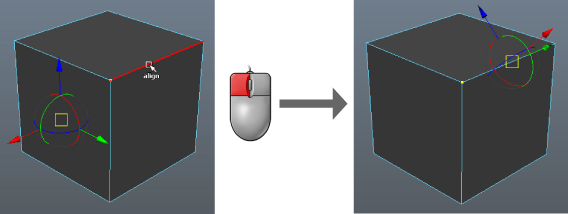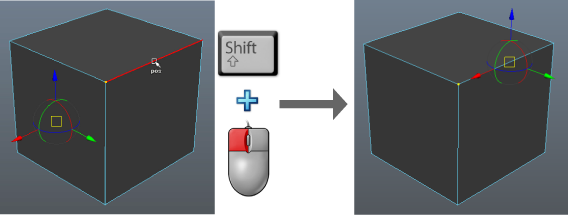
The pivot point defines the position around which objects or components are rotated and scaled. By default, the pivot point of an object or group of objects/components is located at its center. If you want to rotate an around a specific point, like a forearm rotates from an elbow, you need to adjust the pivot's position. Custom Pivot mode is the default method for setting object and component pivot points.
| Transformation | Relationship to Pivot |
|---|---|
|
Move |
Moves the pivot point (and the object travels along with it). |
|
Scale |
Scales object out from or in toward the pivot point.  |
|
Rotation |
Rotates object around the pivot point.  |
To change the pivot point
- Select the object(s) or component(s) to be transformed.
- Select a transform tool.
- Enter
Custom Pivot mode by doing one of the following:
- Press D (or hold it) or Insert.
- Click Edit Pivot in the Tool Settings.
The custom pivot manipulator (the translate and rotate manipulators combined) appears. If you're modeling in component mode, multi-component selection mode activates.
Tip: Use the Pivot Manipulator options in the Manipulator preferences to hide or adjust the orientation handle of the custom pivot manipulator. - Drag the custom pivot manipulator to move or rotate the pivot. You can also use the following hotkeys:
- Click a component to snap and align the pivot to the selected component.

- Ctrl + click a component to snap its axis orientation to the selected component.

- Shift + click to place the pivot at the cursor. If you Shift + click a component, the pivot will snap to that component.
 Tip: As with standard modeling, you can constrain movement to a particular direction by clicking its axis handle in the Pivot Manipulator.
Tip: As with standard modeling, you can constrain movement to a particular direction by clicking its axis handle in the Pivot Manipulator. - Ctrl + Shift + click within the object to aim the pivot at the mouse cursor. If you Ctrl + Shift + click a particular pivot, the following happens:
- If the center handle or X-axis handle is selected, the custom pivot aims its X-axis at the selected component.
- If the Y-axis handle is selected, the custom pivot aims its Y-axis at the selected component.
- If the Z-axis handle is selected, the custom pivot aims its Z-axis at the selected component.
Note: You can also use standard snapping hotkeys when placing pivots. - Click a component to snap and align the pivot to the selected component.
- Exit Custom Pivot mode by repeating step 4.
You can reset a modified pivot's position/orientation at any time by right-clicking the scene and selecting any of the Reset Pivot options (only in Custom Pivot mode).
To reposition an object's pivot using exact values
- Open the Attribute Editor and click the transform node’s tab.
- In the Pivots section, turn on the pivot display options so you can see the effects of editing the pivot values.
- Do one of the following:
- In the Local Space section, type X, Y, and Z coordinates for the Rotate Pivot and Scale Pivot relative to the object’s origin.
- In the World Space section, type X, Y, and Z coordinates for the Rotate Pivot and Scale Pivot relative to the world origin.